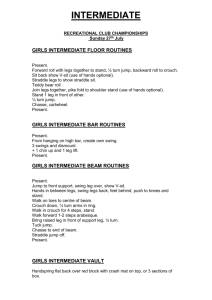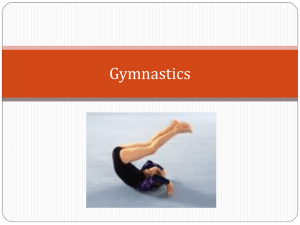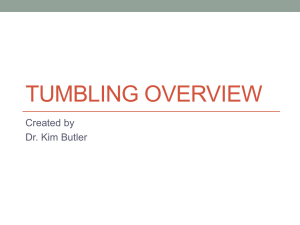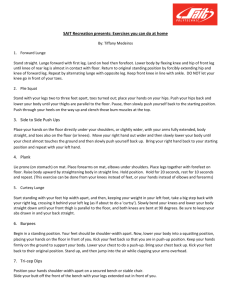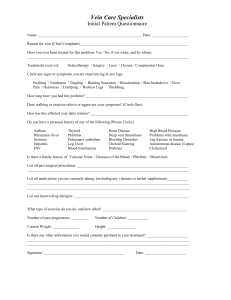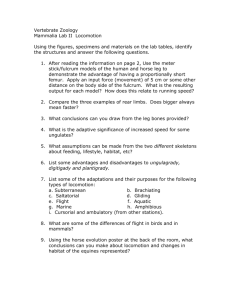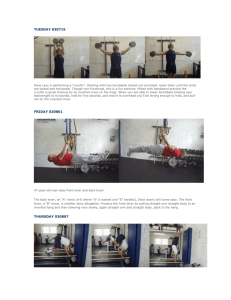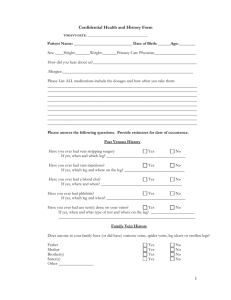Handbook
advertisement
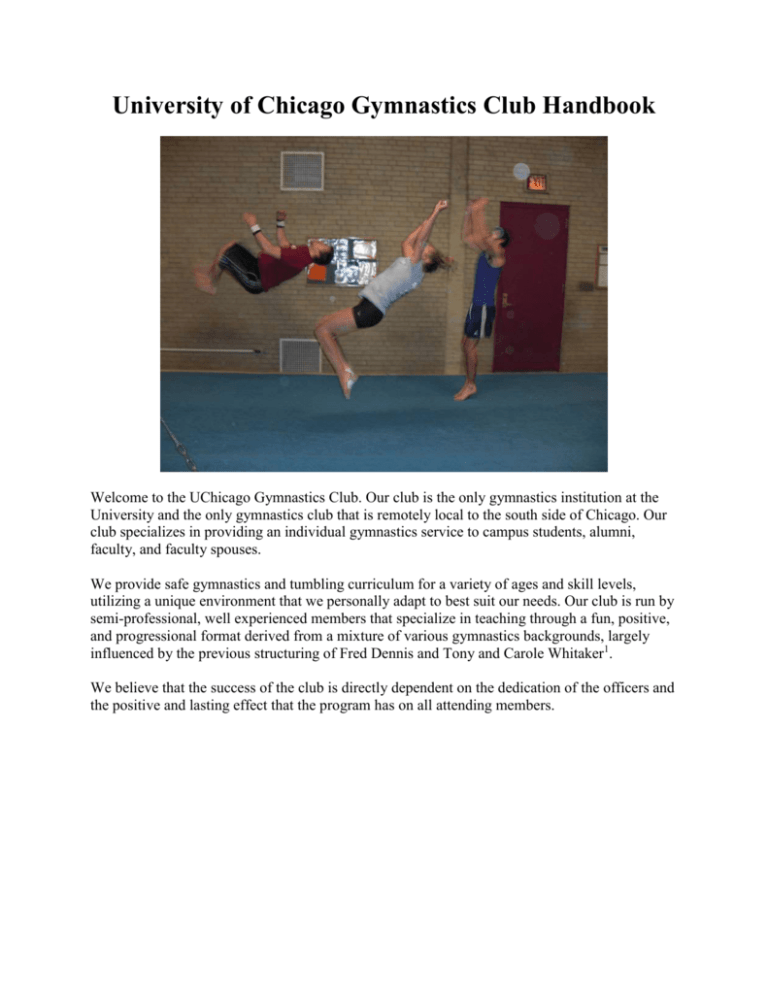
University of Chicago Gymnastics Club Handbook Welcome to the UChicago Gymnastics Club. Our club is the only gymnastics institution at the University and the only gymnastics club that is remotely local to the south side of Chicago. Our club specializes in providing an individual gymnastics service to campus students, alumni, faculty, and faculty spouses. We provide safe gymnastics and tumbling curriculum for a variety of ages and skill levels, utilizing a unique environment that we personally adapt to best suit our needs. Our club is run by semi-professional, well experienced members that specialize in teaching through a fun, positive, and progressional format derived from a mixture of various gymnastics backgrounds, largely influenced by the previous structuring of Fred Dennis and Tony and Carole Whitaker1. We believe that the success of the club is directly dependent on the dedication of the officers and the positive and lasting effect that the program has on all attending members. Club Offices Although our club is continually changing and evolving, the following is a general outline of the different officer positions and some basic duties covered through each position. All officers should be able to attend the majority of the practices, and at least one officer should be present at every single practice. President: Work with sport club director Brian Bock to schedule practices and coordinate these with the supervisors to open the facility. Lead warm-ups during practice and teach the basics to new club members Bring the first aid kit to every practice Attend at least two allocation meetings each year (one orientation meeting in the fall and an important annual meeting in the spring), and any additional quarterly allocation meetings necessary to request further funding Manage the list host and send out practice reminder emails Manage the table at the RSO fair in the fall Organize club trips to outside meets as spectators, or, in the future, organize, attend, and host competitive meets Update the website and online practice schedule (html programming) All the responsibilities of the secretary / treasurer if there is no one. Vice-President: Attend at least two allocation meetings each year (one orientation meeting in the fall and an important annual meeting in the spring), and any additional quarterly allocation meetings necessary to request further funding in accompaniment with the president Assist the President and with his/her duties as necessary and take over if the president is unable to perform them Traditionally, the vice-president takes over the role of president after the president leaves (The vice-president is ideally someone graduating at least a year after the president) (Secretary / Treasurer) Keep track of club membership and attendance Handle club funds. Collect and submit waiver forms and club dues to Brian Bock in the RSO office Contact outside organizations for possible equipment and funding donations Organize and run fundraisers, including the design and sale of club t-shirts (Coach) Organize practice workouts, design routines, spot, give advice, correct form and technique Motivate club members to try newer and harder tricks Design drills and conditioning sets for club members (Publicity Officer) Post flyers and other adds to draw new members to the club Organize and Host Beginner Gymnast Events to make new members comfortable coming Maintain the UChicago Gymnastics Facebook page and update with events and practice time Club Membership and Rules Safety is the #1 Priority! AKA Don’t Be an Idiot Important Rules: Do not do anything that may hurt someone else or yourself A waiver form must be signed before participation of any kind can occur Never dive headfirst or land on your head or neck ever. Never ever. Never. No mat can completely protect you from neck injuries. Only one person on the trampoline at a time – no double bouncing No fighting of any kind – training aerial fighting skills is fine, but they may NOT be practiced on others within the gym Check for proper matting before using any equipment – never dismount onto anything other than landing mats or crash pads Do not attempt a trick you are uncomfortable with – ask an officer for a spot or for training drills to work your way up to the necessary level. Do not spot a team mate if you do not know how to spot the trick properly. Always ask. Do not run through the gym and watch where you walk – if a person is on an event using a mat, walk around the entire mat No destruction or vandalism will be tolerated No alcohol/drug/cigarette use allowed No foul language No food or drink other than water bottles allowed No glass anything or weapons allowed in the gym All members are expected to be positive and encouraging at all times Required Attire: Bare feet No Jewelry including cloth or rubber bracelets, anklets, chokers, rings, necklaces, etc. No chewing gum Flexible but not baggy clothing free of snaps, buttons, zippers (NO JEANS) Long hair in ponytail without any hard pieces Grips, wrist bands, wrist guards, and joint braces are recommended for upper-level tricks Other policies: A $10.00 fee is required each quarter from all members to cover facility management Additional fees will be enacted for intentional destruction of equipment Additional fees may be required for purchase of t-shirts, meet tickets, etc. Equipment Notes o Before practice, clear off the floor, check the high bar and trampoline (below), be sure enough chalk is in the chalk bucket, prop open side door, clear out the springboard(s) – usually next to the pommel horse and vault, and open windows as necessary. o High bar must be tightened with pins firmly inside into holes on each side and with no slack in the air craft cables – use handle to tighten and loosen this – check before practice starts o Rings have frayed cables on higher set – do not wrap your legs around the straps in a handstand or shoulder stand on low rings o Parallel bars are not firmly connected – if one bar appears to lean inwards, remove the mats and make sure that there is overlap between the two holes in the center of the bars – bolt? o Uneven bars are not firmly connected – pull as tight as possible when in use o High bar is low- do not do giants or you will kick the ceiling and cut up your feet on the light o Be cautious on floor of two brick walls, door handle, electrical box, vault, and uneven mats on the edges o The trampoline should not have mats under it. If the trampoline is ever supported by a mat on the canvas, it will tear. If it is supported by a mat under the edge of the frame, the entire frame can break – make sure it is not set up like this ever o Be sure the floor is cleared off before the members arrive so that they have room to stretch o Mats should always be used with any trick. The floor is not soft enough to be a crash mat. o All equipment that is moved or adjusted must be put back at the end of practice (unless it was improperly or unsafely set up to begin with) – it’s their gym, not ours o Be sure the mats are back in the right place, windows are closed, and side door is locked o Chalk is located in the back room – the same key that opens the gym opens that door Practice Structure Although being a member of gymnastics club has no set time commitment, practices will start and end on time, no exceptions. Practices will have several basic parts: 1) Warm-up – to literally warm up and prevent injury 2) Stretching – to prevent injury and improve necessary flexibility 3) Workout – each individual should have a set list of goals to work toward each day 4) Conditioning – to improve strength and endurance 5) Stretching (Opt) – to cool down and further improve flexibility Outside practices may be conducted in Henry Crown or Ratner, such as for free-weight work Below are lists of skills and events that can be incorporated into each: Warm Up This is best accomplished by jogging something like 10 laps around the floor to the point where everyone is slightly out of breath. You can also lead a follow-the-leader type obstacle course around the gym or bounce in place (forward, sideways, tuck, pike, straddle, turns) or do jumping jacks or burpees for a while. This is especially important in the winter time. Stretching Below is a list of basic stretches – each stretch should hurt mildly and be held statically for at least 5 seconds. No rocking as this may over stretch a muscle and cause tears. Stretching should be done with good form for maximum benefit (straight legs, pointed toes, etc) Stand in a straddle and stretch down; left; right; up and back; down and through (LOWER BACK, HAMSTRINGS) Sit in a straddle and stretch to the center – chest to the ground, not nose (BACK, HAMSTRINGS) Sit in a straddle and stretch right arm to right leg and same on the left (HAMSTRING, CALVES) Sit in a straddle and put right arm in toward center then left arm over top to right leg and vice versa (OBLIQUES, HAMSTRING) Sit in a pike, grab your ankles, point your toes, and put your chest and head down (BACK, HAMSTRINGS, CALVES) Sit in a pike and grab your toes pulling your heels off the floor – straight legs (CALVES) Sit in a butterfly, grab your ankles, push your elbows down on your knees (HIP FLEXORS) Put both arms behind you on the ground, shoulder width, and scoot as far forward as you can to stretch your shoulders. Lean your legs to both sides. Try and touch pinkies together (SHOULDERS) Lay chest on ground, one arm out, lean backwards on it. Alternate with other arm. (SHOULDERS) Lay chest on ground, hands waist-side. Push upper body upwards while keeping legs on ground, doing a seal stretch. (ABDOMINALS) Roll out your wrists – while kneeling put them right side up and upside down on floor and push down lightly – also sit back (WRISTS) Sit in pike – grab each ankle and roll it out (ANKLES) Cross one leg across, put opposite arm on opposite of leg and stretch out back (BACK) Grab knee, pull into chest on each side (UPPER HAMSTRING, LOWER GLUTS) Grab foot and try to lift leg over your head (HIP FLEXORS) Bridges – push out toward shoulders – straight arms and legs (BACK, SHOULDERS) Left and right leg splits – leading leg up on mat – hold each two minutes – stay straight (EVERYTHING BELOW WAIST) Center split – one leg up on mat, elbows on ground, knees and toes up (EVERYTHING BELOW WAIST) 3 tuck planches for 5 seconds each (WHOLE BODY) Stand up, stretch arms upwards, across body, and behind head. (SHOULDERS) Arm circles forward and backward. (SHOULDERS) Roll out your neck. (NECK) 10 pushups, 10 sit-ups (WARMUP) Handstand contest (WHOLE BODY) You can also do partner stretching where one person stretches while the other pushes down to further stretch the muscles – this works best if you’re the same size Stretching at the end of practice should focus largely on splits and muscles used throughout the day Work Out (By Event – Each list is a skill progression – you should be able to do one before you do the next trick – they are designed to be done in order; i.e. no running hurdle before standing hurdle) Floor Basics (Skills Progressions) Forward Roll o Down a wedge o On top of a folded panel mat, stand with feet on the floor o On the floor o Forward pike roll (legs straight on way over, bent to stand) o Springboard to wedge, hand on wedge, bounce and roll down o Forward roll up wedge o Forward straddle roll on a folded panel mat, stand on floor o Forward straddle roll on floor o Standing dive roll o Jump hurdle dive roll o Running dive roll o Punch dive roll to raised mat Handstands o Teeter-totter handstand to partial split back to stand o Toe toucher hand stand o Wall handstand, belly towards wall (look at toes, toes only on wall) o Handstand fall flat to cushion o Wall handstand, back to wall o Handstand land in bridge up hill o Bounce to handstand, using donkey kick. o Piourette handstand o Straddle Press to handstand o Pike Press to handstand Handstand forward roll o Handstand forward roll from wall (belly towards wall) o Handstand forward roll down wedge with hands on floor and shoulders against the tall end of the wedge o Handstand forward roll up wedge o Handstand forward roll o Handstand forward roll with arms straight Backward roll o Sitting, down wedge o Squatting, down wedge o Squatting on panel mat, finish off of panel mat o Backward roll on floor o Back straddle roll with legs straight down the wedge o Back straddle roll with legs straight on floor o Back pike roll with legs straight beginning to end o Back pike roll to pushup position o Back pike roll to extension handstand (Back extension with bent arms straight legs) Look for the ceiling and push out o Back extension roll with straight arms, wrists in, and straight legs Cartwheel o Over panel mat o On floor on a line o On floor through valley o Cartwheel onto panel mat o Dive cartwheel o Cartwheel to belly handstand on wall o Cartwheel series (more than one at a time) Also alternate between good side / bad side. o Far arm cartwheel (Do not do close arm cartwheel – second hand only) o Do all cartwheel skills on both sides o Aerial – step, kick, chest up (arch), rotate, hollow past vertical Round off o Off panel mat o On floor o Jump hurdle round-off o Jump hurdle round-off over small barrel/panel mat o Off a panel mat over the barrel o One step blocked round-off on floor with rebound o Hurdle round-off with hands on the floor, feet land on the panel mat o One step round-off with hands on floor, feet land on panel mat o Round off series, doing half-turn on spring and stepping into next one. Bridge o Hands uphill on wedge o On floor o Bridge with hands downhill o Bridge with leg lifts o Bridge kick-over off trapezoid mat o Bridge kick-over on floor o Tick-tocks (hands remain on floor) Backbend o Backbend uphill on soft mat o Backbend on floor o Backbend uphill, return to stand o Backbend on floor, return to stand Back Walkover o Backbend to kick-over o Backbend to one leg bridge o Back walkover on floor Front Walkover Front handspring o Belly handstand to wall (20-30 seconds) o Belly handstand to vertical o Handstand fall flat o Bounce to handstand fall flat (springboard or tumble tract may be implemented) o Handstand back to wall o Handstand from one step lunge, block to layout on cushion o Front handspring off of high mat, land on cushion o Jump hurdle to front handspring to soft mat o Running front handspring to soft mat o Running handspring on floor with rebound Back handspring AKA flip flop o Hollow pushup hold o Handstand to wall (20-30 seconds) o Belly handstand to vertical o Handstand to hollow pushup o Sit drills to wall (lower back touches, no shoulders, no butt, one foot length away from wall, pull belly in to wall) o Straight arm back extension rolls o Jump to layout on high mat o Sit, jump, reach back to tight handstand, fall to hollow pushup o Back handspring to pushup position o Back handspring to stand on trampoline o Back handspring to stand on floor Round-off Flip Flop (Back handspring) o Blocked round off o Standing flip flop o Jump hurdle round off flip flop o Running round off flip flop o Round off flip flop series Bar Basics (High Bar and Uneven Bars) No Boxers Thumbs around highbar, thumbs next to first finger on uneven bars Kip Pulls Leg Lifts o Tuck ups to waist o Tuck ups to chest o Tuck ups to chin o Toe touchers o Straight leg leg lifts o Straddle left lifts Pull-ups o Flexed arm hang o Spotted Pull ups o Full pull ups o Pull up to pull over L-Hangs Front support o Hold o Shrugs Casts – STRAIGHT ARMS o Cast position to hollow – 45, 90, 135 degrees o Cast to handstand o Jump casts off bar o Cast to handstand pirouette Below bar swings o Knees bent o Knees bent with regrip o Glide swings in pike (hold pike) o Glide Kip Pullover o Step kick on low bar o Swinging pullover o Dead hang pullover Back Hip Circle o Spotted From front support o 3 casts back hip circle o Back hip circle with straight arms o Back hip circle in hollow position o Free hip circle spotted o Free hip circle without spot o Free hip to handstand Sole Circles o Hanging sole circle position o Jump to swinging sole circle o Stand on bar in straddle, sole circle all the way around o Sole circle to handstand Tap swings o Tap swings with regrip o Tap swings with ½ turn o Tap swings to pullover o Tap swings to stand on low uneven bar o Tap swings to fly away Squat Ons o Jump to squat on low beam o Climb to squat, jump off o Cast to squat on low bar, jump off o Cast to squat on low bar, catch high bar Undershoots o Hollow hold (20 seconds) o Spotted from front support on low bar o Dismount on low bar o Undershoot to tap swing on high bar Front Hip Circle – at horizontal, pike Clear Hip Circle o From cast to hollow pushup with spot o From cast, clear hip circle, land on block behind bar o Baby Giants o Continuous clear hip circles (two or more) o Clear hip to horizontal, ¾ handstand, handstand Flyaways o Pump swing on low bar to hollow tuck position caught by spotter o Tap swing to spotted fly away on high bar o Jump from low bar to spotted flyaway on high bar o Cast from high bar to spotted flyaway o Cast from high bar to fly away Balance Beam Basics Balance/Static Work – focal point should be the end of the beam and progression is from low beam to high beam o Correct body position: one foot in front of the other, tummy in, butt tucked under, chin up, shoulders down o Arm positions: Hands on hips Fingers on shoulders Side Middle Front middle Low Crown High o Releve Two feet One foot o Plie – slight knee bend, heels pressed down, tummy in, butt under o V-sit – legs together and straight Hands on beam Hands off beam o Knee Scale – Right arm and left legs – arms straight, head up o Lunge – Right and left, body straight, tight, front knee bent o Passe Forward Side (Toe to knee = high, toe to ankle = low) o Clear straddle hold o L Hold o Leg Lift o Scale – chest horizontal, head up o Arabesque – chest vertical, flat foot o Squat – chest vertical Slow movement – focal point is end of beam, progress from low to high beam o Forward walk – flat on toe o Backward walk – flat on toe o Pivot turn in Releve o Leg lifts o Passe walk o Passe to develope walk – extended passé o Stride lunges – push to lunge with correct arms – split to leap position, turn toe under o Squat turn – chest vertical, on toe o Kick turn – kick straight leg forward to horizontal, swing leg backward, as leg passes body, releve on support leg, turn to face other direction as leg lifts to horizontal o Turns – toe to knee Half full Fast movement o Runs – long extended strides in demi plie o Skip – continuous o Chasse – left and right o Step hops (Leap progression) o Hops – continuous Jumps – still focused on end of beam o Straight jump – stretch up and forward o Tuck jumps o Straddle jumps o Split jumps o Assemble – free leg kick to horizontal closing feet together before landing, show flight, land feet together o Sissone – back leg lifts to arabesque, front leg lifts forward, land on front leg in arabesque o Jump half turns – front foot starts and ends in front, arms go up Leaps – head should remain neutral o Step – hop plie take-off landing, free leg in high passé o Arabesque to hope – plie take off and landing, chest vertical o Stride leap o Split leap o Switch leap o Stag leap o Straight leg leap o Tourjette leap Mounts – focal point is at each point of contact o Front support to straddle sit – hands together, legs straight o Front support to clear straddle o Squat on – hands on beam Lift of press Run on Jump to from springboard o Whip up – legs straight past vertical during swing up, land in squat o Handstand Balance to Press to o Cartwheel Dismounts – focal point is end of bean at start and on landing at finish o Straight jump o Tuck jump o Straddle jump o Jump half turn o Round off – show stretch and flight through vertical o Front handspring o Brani o Front (punch) o Wendy – side handstand with a quarter turn, show vertical before dismount Tumbling – focal point is each point of contact (i.e. hands) o Teeter-totter handstand o Toe toucher handstand o Side handstand o Cartwheel – start and finish in lunge, arms next to ears o Back walk over o Back hand spring Vault Basics Approach o Run – on toes, arms bent, head up, full strides Start with one step and work your way to a run, not the other way around o Hurdle – Low approach to the board – feet in front of body, underarm swing o Board Punch – contact the board with extended legs, on the toes – quick repulsion Landing o Land with knees bent, arms up, head neutral, stomach in, butt tucked (C) o Skills: o o o o o o o o o Safety rolls – arms stay by ears, forward and backward Straight jump from board to landing Tuck jump Straight jump, half turn from board to landing Punch to handstand, fall flat to cushion Board punch to two blocks, punch off blocks to straight jump to cushion Handspring over panel mat Punch to handstand on 3 blocks – ARMS STRAIGHT, UNDERARM SWING Hand spring over horse Half on to two blocks, land on stomach on cushion Rings Basics Swings o Thumb around ring, hands at bottom, center of ring o Legs straight and together entire time – put piece of paper between to hold o Push and pull from shoulders each swing (push on back swing, pull on front) o Hands face out on front swing, hands face in on back swing o Head stays neutral, looking ahead – head never looks sideways or downwards o Toes are pointed o Body changes from arch to hollow position through kick from back to front of swing o Let go and land at peak of back swing, not front swing; never land with hands behind Skills o Hanging L hold o Straight leg pull to inverted hang o Skin-the-cat and pull out of it o Basket hang to cast – forwards and backwards o Straight Body Support – minimum 30 seconds – keep shoulders pushed down o Supported L hold – legs held horizontal – 5 secs o Shoulder stand with legs around straps (DO NOT DO ON LOW RINGS) o False Grip pull ups o Support to cross fall through on low rings o Swing to basket and let go (simple flyaway) Pommel Horse Basics (pants recommended) Mushroom Circles o Walk around mushroom with arms straight and legs straight and body extended – person should lean shoulder over wrist as they lift opposite hand o Jump to half circle – should land with body straight and extended out forward o Jump to one circle – must stay extended through swing and block off each hand o Multiple circles – legs should not come apart ever, or bend [mushroom flairs are easier to learn than flairs on the pommel horse] Leg Cuts o Leg lifts up as arm blocks off horse, leg cuts under hand above pommel, lands in front Both legs, cutting forward and backwards o o o o o Arms stay straight and extended, legs stay straight and pointed – no sitting on the horse ever Tick-tock swings – hold tight straddle in back as wide as possible and swing side to side without doing leg cuts Hold straddle with bottom leg on side of horse, top leg above level of head, shoulder over supporting wrist, free hand in air over waist (each side, 30 s) False scissors – start with one leg in front and one in back, put front leg up on side of horse, back leg comes under and finishes in front, other leg finishes in back–each side Full scissor-should be smooth with high swing and visible split. Connect two together Reverse scissor-both hands on one pommel, legs straddle, outside leg swings back, underneath inside leg to the center, finish in the center with one leg forward Circles o One legged circle from leg cut – leg comes through on other side o Jump to two legged circle (go for it all the way or it will hurt) o Continuous circles – stay extended o Attempted Floor Circles Traveling – practice walking on hands around horse holding legs tight together o Start with leg in front – leg cut to straddle L support – two leg cuts, then move hands Exercises o Support in center on both pommels, lift one hand and place in center, lift other hand and place in center. Lift first hand and grasp pommel, then other hand. Repeat and go faster. Parallel Bars Basics Swings o Start with front support, chest up, head neutral, legs straight and together entire time o The goal should be to get the front and back swing to horizontal or further, with legs straight and body extended at shoulders in front Skills o Hold support o L hold in support o V hold in support o L to shoulder stand on bars o L to forward roll on bars o Swing in bent arm support o Bent arm support to back uprise o Bent arm support to front uprise o L hold to backward drop with straight arms o Hanging swing to bent arm support from beneath bars o Hanging swing to kip to support from beneath bars o Drop Kip from support o Baby Giant o Dismount over bars from supported swing – no salto For More Advanced Skills and Illustrated Technique, Check Out the NFHS 2007-09 Skills Book (Compliments of Michael Galfi, Head Coach Addison Trail High School Mens and Womens Gymnastics Teams) Conditioning Depending on the desired skills, gymnastics depends about 25% on physical strength and it is thus very important that muscular conditioning be done each practice the point of muscular exhaustion to increase strength and endurance. It is best to focus on a particular muscle group each day and to then maximize conditioning of that group. Those muscles should then not be directly conditioned for several days. Rest and diet are very important as well in generating greater bodily strength. Below are some basic conditioning exercises: Pushups o Regular, Wide, Tricep with elbows in, Diamond, Clap, Double Clap, etc. o Group pushups: Groups of 4 in a square with legs on the next’s shoulders o Team pushups: Team on floor facing one end – each puts legs on shoulders behind o Elevated – put legs up on block/bar to work shoulders more handstand pushups o Team: On floor shoulder to shoulder – do 5, person on end crawls through, do 5, next person crawls underneath everyone, do 5 etc., Abs o Sit-ups, crunchies (sides), row-boats, v-ups, bicycles, hollow hold, hollow rockers, flutter kicks, planks, toe-touchers; leg lifts, wind shield wipers, pullovers, L holds o Sit on edge of beam, hands on sides facing forward, do timed leg lifts to chest o Grab a vertical pole and do leg lifts to candle stick – lower straight body to floor o Partner – grab a standing partner’s ankle’s as he or she throws your legs down to ground – don’t let toes touch – pull back up to candlestick support o Hollow hold on trampoline while one person jumps over everyone– no touching floor Shoulders and arms o Dips on P-bars – thin, regular, wide, swinging, arched, hopping o Dips on Rings – keep rings turned out o Dips on chair – go as low as possible to work entire muscle o Handstand hold on wall – timed, lift arms, tap shoulders, push shoulders out, etc. o Handstand hold with legs wrapped around ring straps o Handstand pushups o Spotted planche pushups/holds – legs up on box, hands behind shoulders o Chin up, pull ups, and wide pull ups on high bar o Muscle ups on rings Back o Arch ups on vault/box o Presses on Floor o Superman holds/lifts on floor Legs o Frog Jumps on 48” crash mat o Wall sits – have people walk across legs as you travel across wall or pass an object o Tuck holds on floor o Calf raises on beam o Lunges down floor (with weights or with partner on back) Whole Body o Spotted cross pullouts on high rings o Levers on Rings (spot on ankles opt) o Obstacle Course o 20 second V-holds on Parallel bars or floor o Press handstand to straddle down back to press on p-bars Running o Gymnasts should run at least a few times a week outside of practice o Practice both sprints for speed (on toes) and long distance running for endurance Biking is not a comparable workout with running. Ice hockey is. Many exercises can be done together in countdowns or supersets or an obstacle course to increase the number of muscle groups worked that day. Example: Do a countdown with dips and pushups on the parallel bars starting with 10 of each, then 9, etc. until you finish. Current Weight Lifting Schedule: See PDF online It is recommended to do outside free-weight lifting and at least 2 hours of cardio work each week. See the website for conditioning and lifting ideas. Games – may be used as warm up or instead of conditioning or just for fun o Monkey roll: group of 3 on floor – begin in pushup position shoulder to shoulder – inside person rolls to outside as outside person jumps over. New inside person lands and rolls to other outside as s/he jumps over. Continue o Add-on: A group lines up on an event. The first person does one trick. The next person does the same trick plus a new one after. Continue until all players can’t keep up and are eliminated – (opt: punishment for losers i.e. pushups, situps, etc.) o Standing back contest – standing backs on floor – only sticks count – failed attempts have to do sets for conditioning. Works for other tricks as well. o Alligator pit – (Move Vault) Put two 8” crash mats long ways on floor with spring board in front. Everyone jumps with two foot take off. After last person goes, board is pulled back about 6”. Last person to land on red mats without falling in the pit wins. o Dive roll contest – have everyone go to trampoline and dive roll over a foam mat. Raise the mat a little bit after everyone has completed a dive roll. Last one to still be able to make it over wins. o Circle game (guys only, not UChicago) – draw five 5’ diameter circle on 40x40 floor. Split into two teams. One team must stay in circles and drag other team. Other team must drag those in circles outside them. If you touch into the wrong part of the circle, you’re out. Contact is necessary to play. o Box game – stand in a circle with small foam box. Throw the box at each other. A bad throw or a missed catch counts as a strike. Three strikes and you’re out. o Crab Soccer (not Uchicago) – put two boxes at each end of the 40x40 floor. Split into two teams. Roll up one pair of socks into a ball. Each team has one goalie in front of the box. The goal is to throw the ball into (hit) the goal (block). The entire game must be played on the knees or by crawling. Standing isn’t allowed. Tackling is. o Pommel Horse Sock Routines – each member must complete an entire routine without stopping while the other members throw socks at them. o Obstacle course: Divide into two teams. Divide the gym into two equivalent courses with various stations and conditioning at each. Race to finish 3 laps for each person. When one person finishes, the next starts. The first team to finish wins. (A lighter version of this can also be done as a warmup) Many other games exist and can be made up – they make workouts more fun than just doing sets all the time. They’re also useful during competition season when heavy conditioning may make upcoming competitions more difficult. Mock-Meet: A mock meet may be held for fun, to help improve team spirit, to give a chance for everyone to show what they’ve learned, to provide simple competition experience, to allow critique by a large group, to provide necessary pressure to do a certain trick, and to determine who gets to compete in a limited competition meet. Judges should attempt to be impartial and consider all trick values and requirements, as described below. Boys high school Freshman/Sophomore Competition Requirements by event: Tumbling: ½ Twisting Salto, Alternates (Salto, hand/headspring, salto), Bounders (salto salto). Horse: Two scissors in any connection, Two consecutive double leg circles on any part of horse, Double leg skill of at least B Value. Rings: A strength move of A value or better (an L does not meet this. Any varsity strength or an A rule book strength i.e. muscle up, back lever, forward or backward roll, any press hand, straddle front lever, etc…) Lowering through a cross is no longer a skill. A handstand of A value or better. A swing move beginning and ending above the rings. Parallel Bars: Swing or press to handstand of any value, One skill on 2 rails in or through a hang, somersault dismount High Bar: Two over grip giant swings, two under grip giant swings, change of direction out of and into giants. Boys high school Varsity Competition Requirements by event: Tumbling: ½+ Twisting Salto, Strength Skill B+, Front and back tumbling of C+ difficulty, transition moves between skills. Horse: Two scissors in any connection, Two consecutive double leg circles on any part of horse, Double leg skill of at least B Value. Rings: A strength move of B value or better (an L does not meet this. Any varsity strength or an B rule book strength i.e. muscle up, back lever, forward or backward roll, any press hand, straddle front lever, etc…) Lowering through a cross is no longer a skill. A handstand of B value or better. A swing move beginning and ending above the rings. Dismount of B value or greater. Parallel Bars: Swing or press to handstand of B+ value, One skill on 2 rails in or through a hang, somersault dismount High Bar: Two over grip giant swings, two under grip giant swings, change of direction out of and into giants, salto dismount, release move. Girls high school Freshman/Sophomore Competition Requirements by event: Looking for female volunteer to write this still. Girls high school Varsity Competition Requirements by event: Looking for volunteer. Gymnastics Traditions that may or may not be reinstated: Trip to UIC Windy City Invite – Held Each January, this meet at local UIC consists of several of the top college teams in the US, and it is not uncommon to see competitors that later try out for the US Olympic team. This meet is also a good chance to bond as a club and to see high level skills that no one else in the world can do. 40 Day – On this day of extended practice, each person must complete 40 routines to work on endurance and memorizing their routines. Safety comes first, but this day is meant to push people to work harder than ever before and typically no one is allowed to leave the gym until every team member has completed everything. Men’s Summer Meet Competition – Each summer, an individual competition is held at Addison Trail High School in Addison, IL where individuals of any age and skill can enter and compete for fun. The top places on each event in each division receive medals. Divisions are based on number of years of competition experience, not age. Club T-shirt Design – club shirts serve as a fundraiser for the club and a way to show pride in how hard you work. Typically, shirts are designed in fall quarter and then ordered and sold throughout the year to members and other students. Also, to show support, shirts may be given to the RSO director and/or the people that watch the door and allow us to practice. Other General Notes on Running the Gym and Being a Coach USA Gymnastics has set a few standards that are required for a professional instructor. To work in a day care facility, all requirements must be met. Many are also useful to improve coaching for the club at the University of Chicago and can open up other opportunities with gymnastics: USA Gymnastics Professional or Instructor Membership per annual renewal USA Gymnastics Safety Certification every four years CPR and First Aid Every Two Years Movement Education and Lesson Plan Development (MELPD) Certification Kinder Accreditation for Teachers (KAT) Certification Finger Printing for the Department of Child and Family Services Any necessary paper work for the club can be found online at athletics.uchicago.edu or can be obtained at the RSO office in the back of Ratner. Copy codes and print codes can be obtained from the ORCSA office in the basement of Reynolds. Communication: It is very important to the club and is highly recommended that communication between all members (and coaches) occurs as long as it is done in a positive manner. Do not allow rumor or innuendos to create a negative view. If there is a conflict of interest, please discuss it privately between the two parties and do what is objectively best for the club and the majority of the members. General concepts include having a single person giving directions to a group at once, creating a positive atmosphere through smiles, body language, and appearing approachable, acting as an example instead of a distraction, using positive words to create excitement, being enthusiastic, encouraging, honest, trustworthy, etc., and just being yourself. Conflicts: When things begin to go wrong, diffuse the bomb before it explodes and avoid conflict: Have the right mental approach: stay calm, do not get upset, remember the goal is to help, do not let it be personal, honesty is the best policy, be direct, be specific of the undesirable actions – it is the actions, not the person, that is to dislike. Helpful Info: put yourself in another’s perspective, make sure that both groups understand what is wrong, speak with authoritative tone. Basic formula for diffusing a situation: Define unacceptable actions with examples, let them know you want this to work out best for everyone so you can all be happy, describe the desired actions, describe the consequences of continued negative behavior, let them know you believe in their ability to control and change the situation, ask for their support. Be Professional, Remove Emotions
